Golden Retriever owners face a particularly challenging situation when they notice their dog’s abdomen appears swollen, but their beloved companion shows no obvious signs of discomfort. A dog swollen stomach and no pain condition can be one of the most deceptive and dangerous health scenarios for this breed. Unlike obvious bloat symptoms that clearly signal an emergency, silent abdominal swelling often represents the calm before a potentially life-threatening storm.
Understanding the nuances of dogs belly swollen no pain situations becomes crucial for Golden Retriever owners, as this breed’s stoic nature and high pain tolerance can mask serious developing conditions. The absence of obvious distress doesn’t guarantee safety. In fact, it often indicates the early stages of gastric dilatation that could rapidly progress to GDV (Gastric Dilatation-Volvulus), a condition that claims lives within hours if left untreated.
This comprehensive guide explores the critical warning signs, medical causes, and appropriate responses when Golden Retrievers develop stomach swelling (Hard Stomach) without apparent pain. By recognizing these subtle early indicators and understanding when silent symptoms require immediate action, owners can potentially save their pet’s life during those crucial early intervention windows.
Contents
- 1 Understanding a Dog Swollen Stomach No Pain in Golden Retrievers
- 2 Early Warning Signs When a Dog Swollen Stomach No Pain Develops
- 3 Dogs Belly Swollen No Pain vs. Emergency Bloat Symptoms
- 4 Medical Causes Behind Golden Retriever Stomach Swelling Without Pain
- 5 What to Do When You Notice Dog Swollen Stomach No Pain
- 6 Prevention Strategies for Dogs Belly Swollen No Pain Episodes
- 7 Long-Term Monitoring for Golden Retrievers with Silent Bloat History
- 7.1 Establishing Home Monitoring Routines
- 7.2 Veterinary Partnership for Ongoing Care
- 7.3 Is dog swollen stomach no pain always a sign of bloat?
- 7.4 How long can dogs belly swollen no pain condition last safely?
- 7.5 Can Golden Retrievers have bloat without showing pain?
- 7.6 What should I do if I notice dog swollen stomach with no pain in my Golden Retriever?
- 7.7 Are there ways to prevent dog swollen stomach no pain?
- 7.8 How is a dog’s swollen stomach with no pain different from obvious bloat symptoms?
- 7.9 Should I try home remedies for dogs belly swollen no pain?
- 7.10 When does dog swollen stomach no pain become an emergency?
- 8 Final Thoughts: Recognizing Silent Bloat in Golden Retrievers.
Understanding a Dog Swollen Stomach No Pain in Golden Retrievers
Golden Retrievers experiencing abdominal swelling without obvious discomfort present unique challenges for even experienced dog owners. The combination of this breed’s naturally deep chest structure, genetic predisposition to bloat, and characteristically calm temperament creates scenarios where serious conditions develop silently before becoming obvious emergencies.
What Causes Dogs Belly Swollen No Pain Conditions
Several factors contribute to dogs belly swollen no pain in Golden Retrievers, with early-stage gastric dilatation being the most concerning. During initial bloat development, the stomach begins filling with gas, food, or liquid, creating visible distension before pain receptors trigger obvious discomfort responses. This early phase can last 30 minutes to several hours, providing a critical window for intervention before the condition becomes life-threatening.
Food accumulation represents another common cause of dog swollen stomach no pain conditions. Golden Retrievers, known for their enthusiastic eating habits, may consume large quantities quickly, causing significant stomach expansion that appears concerning but initially remains comfortable. However, this rapid consumption increases the risk of stomach hardening and can trigger the cascade of events leading to true bloat.
Gas buildup from dietary factors, stress, or digestive issues can also create dogs belly swollen no pain. Certain foods, eating too quickly, or consuming inappropriate items can cause excessive gas production that distends the stomach without immediately causing pain. Golden Retriever stomach issues often begin with these seemingly minor digestive disturbances that gradually escalate into more serious conditions.
Why Golden Retrievers Hide Discomfort During Stomach Swelling
Golden Retrievers possess natural characteristics that make recognizing early dog swollen stomach no pain conditions, particularly challenging. Their breeding history as working dogs selected for resilience and high pain tolerance means they often continue normal activities even when experiencing significant internal pressure or discomfort. This stoic nature, while admirable in many contexts, can prove dangerous when early intervention could prevent emergencies.
The breed’s naturally calm and people-pleasing temperament contributes to their tendency to hide discomfort. Golden Retrievers may continue eating, responding to commands, and engaging in normal activities even when their stomach feels increasingly uncomfortable. This behavior pattern makes the dogs belly swollen no pain phase, especially deceptive, as owners may assume their pet feels fine based on apparently normal behavior.
Additionally, Golden Retriever bloat often develops gradually rather than suddenly, allowing dogs to adapt to increasing pressure over time. This gradual progression means that by the time obvious pain symptoms appear, the condition has often progressed beyond the optimal intervention window. Understanding this breed-specific response pattern helps owners recognize when subtle changes should trigger concern rather than waiting for obvious distress signals.
Early Warning Signs When a Dog Swollen Stomach No Pain Develops
Recognizing the subtle indicators of developing stomach problems in Golden Retrievers requires understanding how this breed typically responds to internal discomfort. The early warning signs often manifest as minor changes in routine behavior or physical appearance that inexperienced owners might dismiss as normal variations.
Physical Changes in Golden Retrievers Before Pain Appears
Visual changes in abdominal appearance represent the most obvious early indicator of dog swollen stomach no pain conditions. Golden Retrievers developing early-stage bloat often show subtle changes in their torso silhouette, with the area behind the ribs appearing slightly fuller or rounder than normal. This change may be most noticeable when viewing the dog from the side, where the normal gentle curve of the abdomen becomes more pronounced or distended.
The stomach region may feel firmer than usual during gentle palpation, though not yet rigid like the drum-tight feel characteristic of advanced bloat. During this dogs stomach hard early phase, the abdomen maintains some give when pressed gently, distinguishing it from the rock-hard feel of emergency GDV conditions. However, this firmness represents a significant change from the normal soft, pliable feel of a relaxed stomach.
Posture alterations often accompany physical abdominal changes during dog swollen stomach no pain development. Golden Retrievers may begin favoring certain positions, avoiding lying on their stomach, or showing reluctance to bend down for food or water bowls. These position preferences reflect their body’s attempt to minimize pressure on the distended stomach area, even though obvious pain hasn’t yet developed.
Breathing patterns may show subtle changes as the expanding stomach begins pressing against the diaphragm. While not yet the rapid, shallow breathing of emergency bloat, dogs may breathe slightly more deeply or show minor changes in their normal respiratory rhythm. These early respiratory changes often go unnoticed unless owners specifically observe their pet’s normal breathing patterns for comparison.
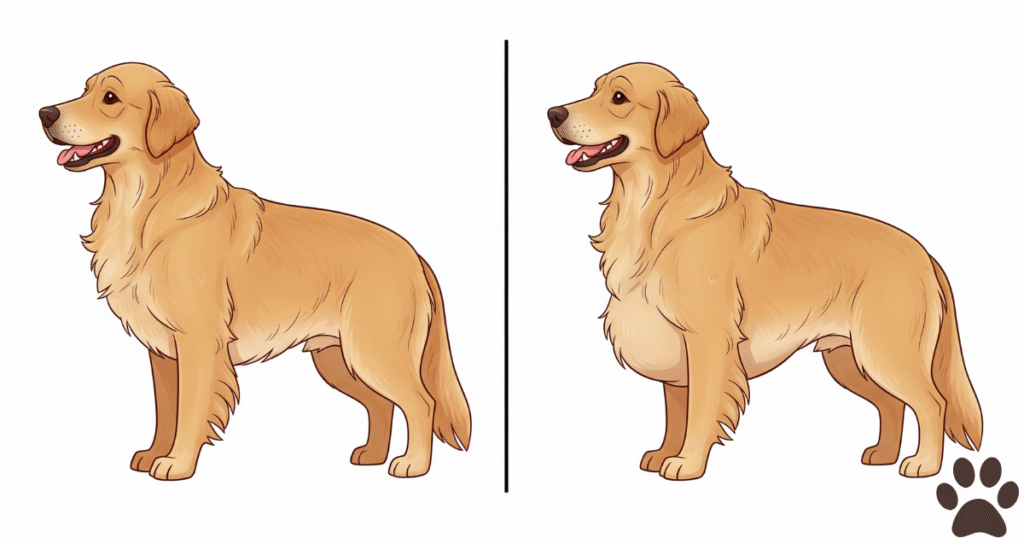
Behavioral Indicators During Silent Bloat Phases
Behavioral changes during dogs belly swollen no pain often manifest as subtle shifts in normal activity patterns rather than obvious distress signals. Golden Retrievers may show decreased enthusiasm for activities they typically enjoy, such as walks, play sessions, or training exercises. This reduced interest doesn’t represent complete avoidance but rather a noticeable decrease in their normal excitement levels.
Eating pattern changes frequently occur during early dog swollen stomach no pain development. Dogs may eat their regular meals but show less eagerness, take longer to finish, or leave small amounts of food – behaviors that contrast with their typical enthusiastic eating habits. Some Golden Retrievers begin eating more slowly or taking breaks during meals, reflecting their body’s instinctive response to increasing abdominal pressure.
Social interaction patterns may shift subtly as dogs experiencing my dogs stomach is hard but acting normal, conditions begin showing minor preference changes. They might seek more attention from owners, or conversely, prefer to rest in quiet locations away from household activity. These changes often occur gradually over several hours, making them easy to overlook unless owners maintain awareness of their pet’s normal social patterns.
Sleep and rest position preferences commonly change during early stomach swelling episodes. Golden Retrievers may avoid their normal sleeping positions, particularly those involving lying on their stomach or side, instead preferring to sleep sitting up or in positions that minimize abdominal pressure. This positional awareness represents their body’s natural attempt to remain comfortable while internal pressure gradually increases.
Dogs Belly Swollen No Pain vs. Emergency Bloat Symptoms
Understanding the progression from subtle stomach swelling to a life-threatening emergency helps Golden Retriever owners make critical decisions about when to seek veterinary care. The transition from dogs belly swollen no pain to an obvious bloat emergency can occur within hours, making early recognition and intervention crucial for successful outcomes.
Progressive Timeline from Silent to Critical Stages
The progression from dog swollen stomach no pain to emergency bloat typically follows a predictable timeline, though individual variation exists based on factors like dog size, underlying Health, and the specific trigger causing the stomach distension. Understanding this timeline helps owners recognize when a seemingly manageable situation is becoming dangerous.
During the initial 30 minutes to 2 hours, Golden Retrievers may show only subtle signs of abdominal fullness without obvious distress. The dogs stomach hard feeling may be barely noticeable, and behavioral changes remain minimal. This early window represents the optimal time for intervention, though the subtle nature of symptoms often means this phase goes unrecognized until later stages develop.
Hours 2-4 typically bring more noticeable physical changes as stomach distension increases. The dog swollen stomach no pain condition becomes more visually obvious, with clear abdominal enlargement visible from multiple angles. Behavioral changes intensify during this phase, with reduced activity levels and subtle discomfort becoming more apparent to observant owners.
The transition to obvious emergency symptoms usually occurs 4-6 hours after initial onset, though this timeline can compress rapidly under certain circumstances. During this critical transition, dogs belly swollen no pain conditions evolve into obvious distress with restlessness, drooling, unsuccessful vomiting attempts, and clear signs of significant discomfort. This progression marks the point where immediate emergency veterinary care becomes essential for survival.
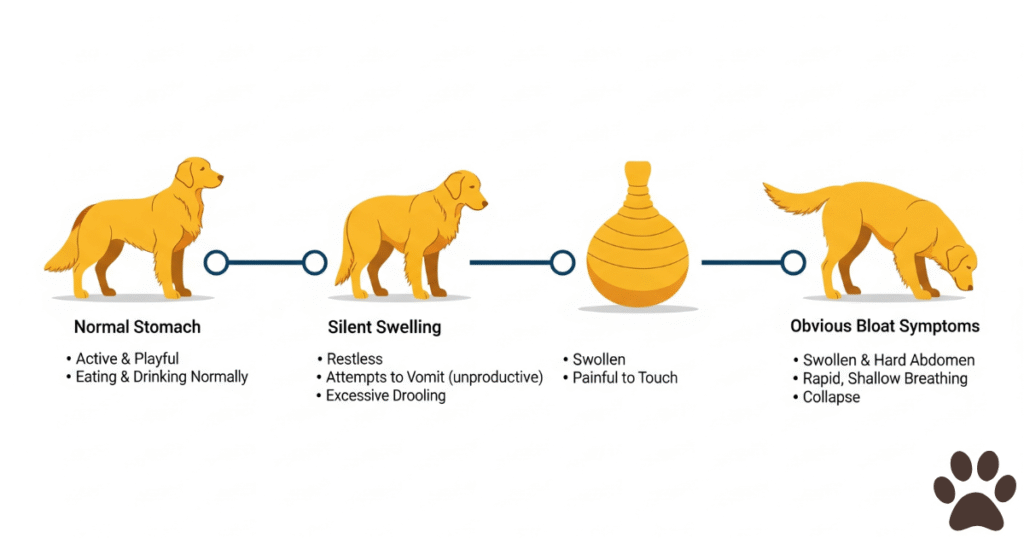
When Painless Swelling Becomes Life-Threatening
The transformation from dog swollen stomach no pain to a life-threatening emergency often occurs when the distended stomach begins rotating or when internal pressure reaches levels that compromise blood circulation. This transition point represents the difference between manageable gastric dilatation and potentially fatal GDV (Gastric Dilatation-Volvulus).
Several warning signs indicate when dogs belly swollen no pain is progressing toward emergency status. Unsuccessful attempts to vomit, where dogs go through vomiting motions but produce only foam or nothing at all, signal that stomach contents have become trapped. This symptom marks a critical escalation requiring immediate veterinary intervention, as it often indicates the stomach has begun twisting.
Increased restlessness combined with persistent abdominal swelling signals the transition from comfortable distension to problematic pressure buildup. Golden Retrievers who were previously calm despite their swollen stomach may begin pacing, unable to find comfortable positions, or showing signs of a flipped stomach in dogs development. This behavioral shift indicates the condition is progressing beyond the safe observation phase.
Gum color changes, particularly pale or blue-tinged gums, indicate compromised circulation and mark the progression from manageable stomach swelling to systemic emergency. When combined with dogs stomach hard rigidity and obvious distress, these symptoms indicate GDV development requiring immediate surgical intervention to prevent fatal complications.
Medical Causes Behind Golden Retriever Stomach Swelling Without Pain
Understanding the various medical conditions that can cause dog swollen stomach no pain helps owners make informed decisions about their pet’s care and appropriate response timing. While some causes resolve naturally with time and monitoring, others require immediate professional intervention to prevent serious complications.
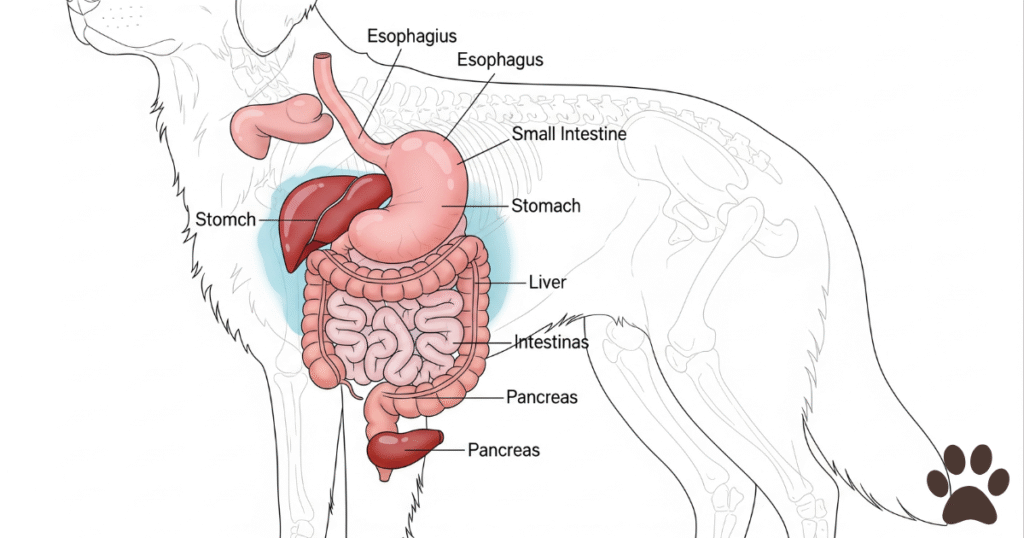
Gastric Dilatation in Early Stages
Early-stage gastric dilatation represents the most serious cause of dogs belly swollen no pain conditions in Golden Retrievers. During this initial phase, the stomach rapidly fills with gas, often triggered by factors like rapid eating, drinking large quantities of water, exercise after meals, or stress-related digestive changes. The stomach expansion occurs gradually enough that pain receptors haven’t yet triggered obvious distress responses.
The physiological process begins when gas production increases beyond the stomach’s normal ability to release pressure through burping or normal digestion. Golden Retriever bloat susceptibility stems from their large size, deep chest structure, and genetic predisposition, making them particularly vulnerable to this gas accumulation process. The expanding stomach creates visible abdominal distension while internal pressure builds toward dangerous levels.
During this early phase, the stomach remains in its normal anatomical position, distinguishing simple gastric dilatation from the more dangerous twisted stomach in dogs. However, this expanded stomach becomes increasingly likely to rotate as internal pressure builds, particularly if dogs move vigorously or continue eating and drinking. The pre-volvulus phase represents a critical intervention window where decompression procedures can prevent progression to life-threatening stomach twisting.
Recognition of early gastric dilatation requires understanding that dog swollen stomach no pain doesn’t guarantee safety. The absence of obvious distress often indicates the condition hasn’t yet progressed to critical stages. Still, the visible swelling represents a significant risk for rapid progression to emergency status requiring immediate veterinary evaluation and potential intervention.
Other Conditions Mimicking Silent Bloat
Several conditions can create dogs belly swollen no pain that mimic early-stage bloat but have different causes and prognoses. Food bloat, resulting from consuming excessive amounts of food or treats, can cause significant abdominal distension without the gas pressure characteristic of true gastric dilatation. This condition typically resolves naturally as digestion progresses, though monitoring remains important to ensure symptoms don’t worsen.
Fluid retention in the abdominal cavity, known as ascites, can create dog swollen stomach no pain symptoms that persist over longer periods than typical bloat. This condition may result from heart disease, liver problems, kidney issues, or other systemic conditions affecting fluid balance. Unlike gas-related bloat, ascites develops gradually and doesn’t typically progress to emergency status rapidly, though underlying causes require veterinary evaluation.
Intestinal blockages can create abdominal distension that initially appears painless, particularly during the early stages when obstruction is partial. Golden Retrievers, known for consuming inappropriate items, may develop blockages that cause stomach swelling as digestion backs up behind the obstruction point. This condition requires professional diagnosis and treatment, but typically doesn’t follow the rapid progression pattern of GDV.
Pregnancy in unspayed females creates obvious abdominal enlargement that owners might confuse with stomach swelling. While pregnancy doesn’t represent an emergency, the physical changes can be concerning for owners unfamiliar with canine pregnancy progression. Understanding why my dog’s stomach is hard during pregnancy helps distinguish reproductive conditions from digestive emergencies requiring immediate attention.
What to Do When You Notice Dog Swollen Stomach No Pain
Appropriate response to dogs belly swollen no pain situations requires balancing careful observation with readiness for immediate action if symptoms progress. Golden Retriever owners must develop skills for assessing their pet’s condition while understanding when professional veterinary evaluation becomes necessary for safety.
Immediate Assessment Steps for Golden Retriever Owners
The first step when noticing dog swollen stomach no pain involves systematic evaluation of the severity and progression of abdominal swelling. Begin by gently palpating the abdomen to assess firmness, noting whether the stomach feels soft and pliable, moderately firm, or rigid like a drum. Document the time when swelling was first noticed and any activities that preceded the observation, as this timeline information helps veterinary professionals assess urgency levels.
Observe your Golden Retriever’s overall demeanor and behavior patterns, comparing current activity levels to normal baseline behavior. Note whether they’re eating and drinking normally, showing interest in surroundings, and maintaining normal posture and movement patterns. Dogs experiencing my dogs stomach is hard but acting normal situations, may continue regular activities while internal pressure builds, making behavioral assessment crucial for determining intervention timing.
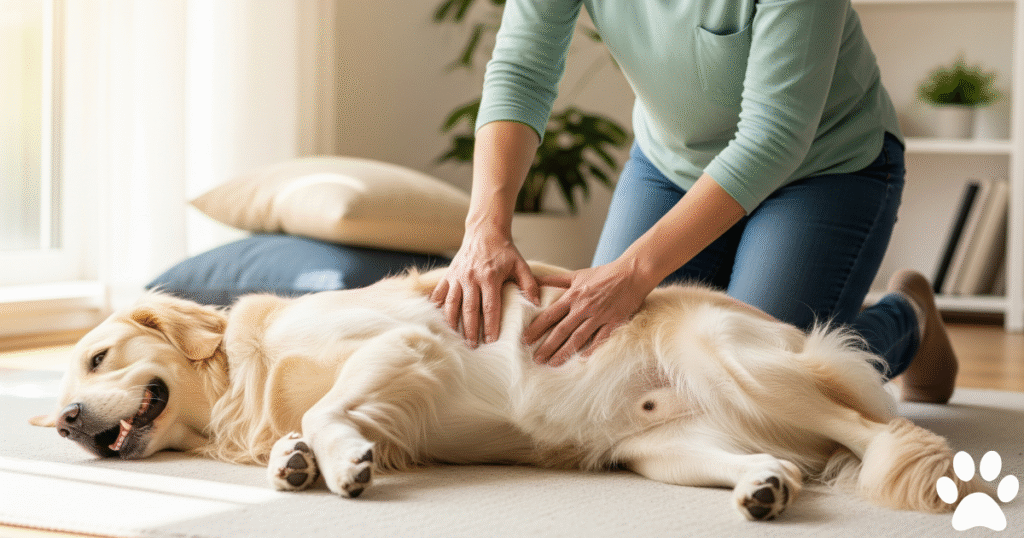
Take photographs of the abdominal distension from multiple angles to document the degree of swelling and provide visual reference points for progression assessment. These images prove valuable for veterinary consultation and help track whether the dog tummy hard condition is worsening, improving, or remaining stable over time. Digital documentation provides objective evidence that memory alone cannot provide during stressful situations.
Restrict food and water access temporarily to prevent worsening of potential gastric dilatation while monitoring continues. This precautionary step reduces the risk of adding additional content to an already distended stomach, though water should not be withheld for extended periods. Continue monitoring for any changes in breathing patterns, gum color, or behavioral indicators that might signal progression toward emergency status.
Emergency Decision-Making Guidelines
Determining when dogs belly swollen no pain requires immediate veterinary attention involves understanding specific warning signs that indicate progression beyond safe observation periods. Contact your veterinarian or emergency clinic immediately if abdominal swelling persists beyond 2-3 hours, increases in severity, or is accompanied by any changes in behavior, breathing, or attempts to vomit.
Establish clear communication with veterinary professionals by preparing relevant information before calling. Document the timeline of symptom development, any potential triggers like recent meals or activities, current breathing and behavior status, and degree of abdominal firmness. This information helps veterinary staff assess urgency levels and provide appropriate guidance for your specific situation.
Transport preparation becomes important when dogs stomach hard conditions that require professional evaluation. Keep your Golden Retriever as calm and still as possible during transport, allowing them to assume whatever position provides the most comfort. Avoid inducing vomiting or giving any medications unless specifically directed by veterinary professionals, as these interventions can worsen certain conditions.
Emergency veterinary facilities should be contacted immediately if dogs belly swollen no pain progresses to include obvious distress, unsuccessful vomiting attempts, pale gums, rapid breathing, or collapse symptoms. These signs indicate progression to GDV or other serious conditions requiring immediate surgical intervention. Time becomes critical once these emergency symptoms appear, making rapid transport and professional treatment essential for survival.
Prevention Strategies for Dogs Belly Swollen No Pain Episodes
Preventing dog swollen stomach no pain situations focuses on managing known risk factors that contribute to gastric dilatation and bloat development in Golden Retrievers. While genetic predisposition cannot be eliminated, environmental and management factors can be modified significantly to reduce the likelihood of developing these dangerous conditions.
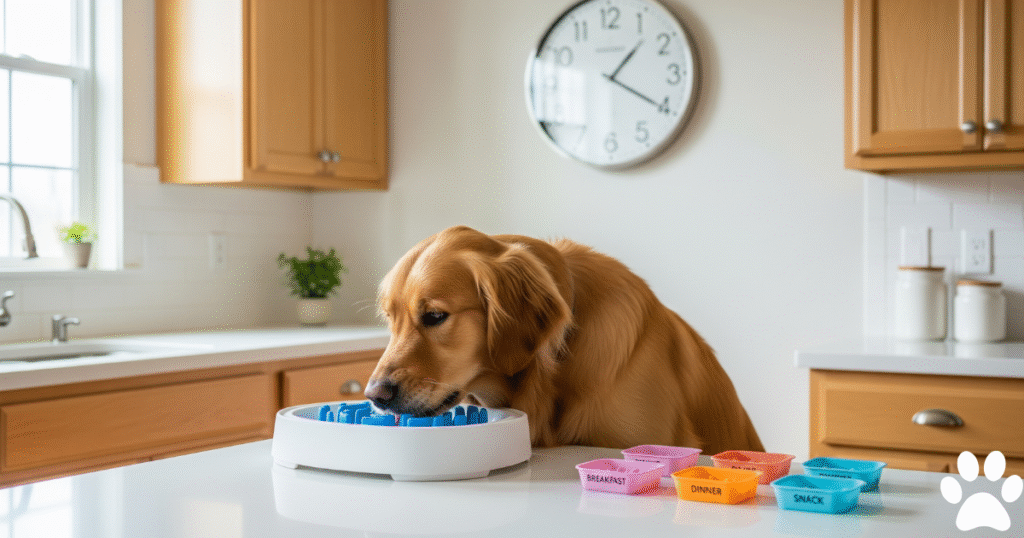
Feeding Management to Prevent Silent Bloat
Proper feeding strategies represent the most important factor in how to prevent twisted stomach in dogs and reducing the risk of dogs belly swollen no pain. Dividing daily food portions into two or three smaller meals rather than one large meal prevents rapid stomach distension that can trigger bloat development. This approach allows more gradual stomach filling and emptying, reducing pressure buildup that leads to dangerous gas accumulation.
Slow-feeding techniques help prevent the rapid food consumption that contributes to Golden Retriever stomach issues. Puzzle feeders, slow-feeding bowls with ridges or obstacles, and scatter feeding methods encourage dogs to eat more slowly and chew thoroughly. These techniques reduce the amount of air swallowed during eating, decreasing gas buildup that contributes to stomach distension and potential bloat development.
Ground-level feeding bowls are recommended over elevated feeders for Golden Retrievers, as research indicates elevated feeding may actually increase bloat risk in some large breeds. Feeding from floor level encourages a more natural eating posture and may help prevent excessive air intake during meals. However, individual dogs with specific joint or neck issues should have their feeding height determined in consultation with veterinary professionals.
Water management around meal times helps prevent rapid stomach expansion from combining large volumes of food and liquid simultaneously. While dogs should always have access to fresh water, some veterinarians recommend limiting large volumes of water consumption immediately before and after meals. This approach reduces the total volume of stomach contents during peak expansion periods while maintaining proper hydration.
Lifestyle Modifications for High-Risk Golden Retrievers
Exercise timing represents a critical component in preventing dog swollen stomach no pain episodes, particularly for Golden Retrievers with high activity levels. The most important rule involves avoiding vigorous exercise for at least one hour before meals and two hours after eating. This waiting period allows the stomach to empty sufficiently before physical activity that could contribute to stomach twisting or increased gas production.
Stress reduction plays an important role in digestive health and bloat prevention for sensitive Golden Retrievers. Maintaining calm, consistent feeding routines and minimizing stressful situations around meal times helps create an environment less conducive to rapid eating and digestive upset. Some dogs benefit from feeding in quiet locations away from household activity or other pets that might create competitive eating situations.
Environmental factors like temperature and household activity levels can influence digestion and gas production in susceptible dogs. Feeding in cool, calm environments and avoiding excitement or stress immediately after meals helps promote normal digestive processes. Some Golden Retrievers benefit from brief, gentle walks 30-45 minutes after eating to aid digestion, though vigorous exercise should still be avoided during this period.
Routine establishment helps reduce anxiety and stress-related digestive issues that can contribute to dogs stomach hard conditions. Consistent meal times, regular exercise schedules, and predictable daily routines help maintain optimal digestive function. Golden Retrievers thrive on routine, and this consistency may help prevent stress-related factors that contribute to bloat development.
Long-Term Monitoring for Golden Retrievers with Silent Bloat History
Golden Retrievers who have experienced dogs belly swollen no pain episodes require ongoing monitoring and management to prevent future occurrences and detect early warning signs of developing problems. Understanding normal baseline conditions and recognizing subtle changes helps owners provide optimal long-term care for at-risk dogs.
Establishing Home Monitoring Routines
Regular abdominal assessment becomes an important part of routine care for Golden Retrievers with a history of stomach swelling episodes. Weekly gentle palpation of the abdomen helps owners become familiar with their pet’s normal stomach feel and appearance, making it easier to recognize when conditions deviate from baseline. This hands-on familiarity proves invaluable during future episodes when quick assessment is needed.
Documentation systems help track patterns and identify potential triggers for dog swollen stomach no pain episodes. Maintaining records of feeding times, exercise activities, stress events, and any digestive symptoms helps identify patterns that may contribute to stomach problems. This information proves valuable for veterinary consultations and helps develop personalized prevention strategies for individual dogs.
Baseline photography of normal abdominal appearance provides reference points for future comparison during potential episodes. Taking photos of your Golden Retriever’s normal profile from multiple angles creates a visual reference that can be compared to future situations when assessing whether the dogs stomach hard conditions develop. These baseline images prove particularly helpful during stressful situations when objective assessment becomes difficult.
Weight monitoring helps detect gradual changes that might indicate developing health issues contributing to digestive problems. Weekly weigh-ins and body condition assessments help identify trends that might not be obvious from day-to-day observation. Sudden weight changes, particularly weight loss, can indicate underlying conditions that increase bloat risk or affect overall digestive health.
Veterinary Partnership for Ongoing Care
Regular veterinary checkups become even more important for Golden Retrievers with a history of dogs belly swollen no pain conditions. These visits allow for early detection of developing problems and adjustment of prevention strategies based on the dog’s changing needs and health status. Veterinarians can assess risk factors and recommend modifications to diet, exercise, or medications as needed.
Preventive gastropexy represents a surgical option for Golden Retrievers at particularly high risk of recurrent bloat episodes. This procedure involves permanently attaching the stomach to the abdominal wall, preventing the rotation that characterizes GDV while still allowing normal gastric dilatation. Discussion of this preventive surgery should include consideration of the dog’s age, overall health, Bloat history, and lifestyle factors.
Emergency planning ensures rapid response capability during future episodes when dog swollen stomach no pain conditions develops. Establishing relationships with emergency veterinary clinics, maintaining updated emergency contact information, and having transportation plans ready helps ensure prompt professional care when needed. This preparation proves crucial during the stress of actual emergencies.
Golden Retriever health management requires ongoing collaboration between owners and veterinary professionals to optimize prevention strategies and early intervention protocols. Regular communication about changes in behavior, appetite, or digestive patterns helps maintain vigilance for developing problems while ensuring appropriate response when concerning symptoms appear.
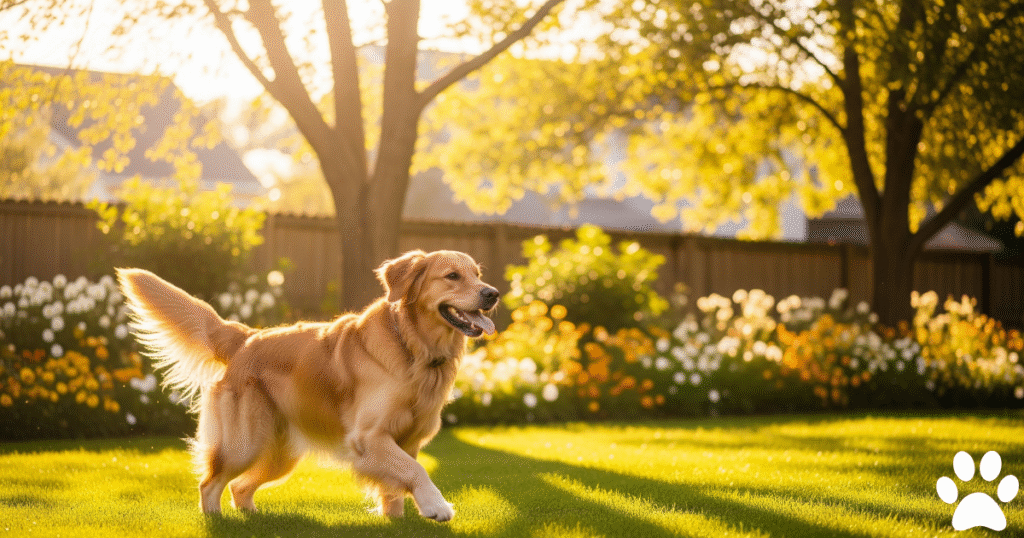
Is dog swollen stomach no pain always a sign of bloat?
Not always. While dog swollen stomach no pain can indicate early-stage bloat in Golden Retrievers, it may also result from overeating, gas buildup, food accumulation, or other digestive issues. However, given Golden Retrievers’ susceptibility to bloat, any persistent abdominal swelling warrants careful monitoring and potentially veterinary evaluation, even without obvious pain signs. The key is understanding that the absence of pain doesn’t guarantee safety, particularly in breeds prone to GDV.
How long can dogs belly swollen no pain condition last safely?
A dogs belly swollen no pain situation should not persist beyond 2-3 hours after meals in healthy Golden Retrievers If swelling continues or increases without pain, this could indicate developing bloat that hasn’t yet caused obvious discomfort. Early intervention during this “silent” phase often provides better outcomes than waiting for pain symptoms to appear. Any abdominal swelling lasting longer than 3-4 hours, regardless of pain level, should prompt veterinary consultation.
Can Golden Retrievers have bloat without showing pain?
Yes, Golden Retrievers can experience early-stage bloat with dog swollen stomach no pain symptoms. Their stoic nature and high pain tolerance mean they may not immediately display distress. This breed characteristic makes owner vigilance crucial – watching for subtle changes in behavior, eating patterns, and abdominal appearance, even when dogs seem comfortable. The “silent bloat” phase represents a critical intervention window before the condition progresses to an obvious emergency status.
What should I do if I notice dog swollen stomach with no pain in my Golden Retriever?
Monitor your Golden Retriever closely and document the swelling’s progression. Gently palpate the abdomen to assess firmness, observe for behavioral changes, and restrict food and water temporarily. Take photos for documentation and timing reference. If the dog’s belly is swollen, no pain condition persists beyond 2-3 hours, worsens, or any additional symptoms appear, contact your veterinarian immediately. Trust your instincts – when in doubt, seek professional evaluation.
Are there ways to prevent dog swollen stomach no pain?
Yes, prevention strategies include feeding smaller, more frequent meals, using slow-feeder bowls, avoiding vigorous exercise around meal times, and managing stress levels. Feed from ground-level bowls, maintain consistent routines, and monitor for triggers that seem to precede episodes. For Golden Retrievers with recurring episodes of belly swelling with no pain, discuss prophylactic gastropexy with your veterinarian to prevent future stomach twisting. Prevention remains more effective than treatment for this serious condition.
How is a dog’s swollen stomach with no pain different from obvious bloat symptoms?
A Dog swollen stomach no pain represents early-stage bloat before severe symptoms develop. Unlike obvious bloat with restlessness, drooling, and distress, silent swelling may only show subtle behavioral changes and physical distension. However, both conditions can rapidly progress to life-threatening emergencies requiring immediate veterinary intervention. The main difference lies in timing – silent swelling provides an earlier intervention window, while obvious symptoms indicate more advanced progression requiring emergency treatment.
Should I try home remedies for dogs belly swollen no pain?
No, avoid home remedies when you notice dogs belly swollen no pain conditions. Do not attempt to induce vomiting, give medications, or try to relieve gas through physical manipulation. These interventions can worsen the condition, particularly if the stomach has begun twisting. Instead, monitor closely, restrict food and water, and contact your veterinarian for guidance. Professional evaluation is always safer than attempting home treatment for potentially serious conditions.
When does dog swollen stomach no pain become an emergency?
Dog swollen stomach no pain becomes an emergency when accompanied by unsuccessful vomiting attempts, excessive drooling, restlessness, pale gums, rapid breathing, or continued worsening after 3-4 hours. These signs indicate progression from simple gastric dilatation to potential GDV, requiring immediate surgical intervention. Additionally, if the dogs stomach hard condition develops alongside any behavioral changes or if the swelling becomes obviously painful, seek emergency veterinary care immediately. Time becomes critical once progression begins.
Final Thoughts: Recognizing Silent Bloat in Golden Retrievers.
Understanding dog swollen stomach no pain conditions in Golden Retrievers requires recognition that the absence of obvious distress doesn’t guarantee safety. This breed’s natural stoicism and high pain tolerance can mask serious developing conditions during crucial early intervention windows. Silent bloat represents one of the most challenging scenarios for dog owners, as the calm appearance often belies the serious nature of internal changes occurring within the digestive system.
The key to protecting Golden Retrievers from silent bloat complications lies in developing familiarity with normal abdominal appearance and behavior patterns, enabling quick recognition when a dogs belly swollen no pain conditions developing. This vigilance, combined with understanding of appropriate response protocols and prevention strategies, provides the best protection against progression to life-threatening emergencies.
Prevention remains the most effective approach to managing bloat risk in Golden Retrievers, focusing on feeding management, exercise timing, and stress reduction. However, even with optimal prevention strategies, the genetic predisposition of this breed means owners must maintain awareness of early warning signs and readiness for prompt veterinary intervention when concerning symptoms appear.
Remember that dogs belly swollen no pain situations demand careful monitoring, regardless of how comfortable the dog appears. Early recognition and appropriate response during the silent phase of bloat development often determine the difference between successful management and tragic outcomes. Golden Retriever owners equipped with this knowledge are better prepared to provide the vigilant care this wonderful breed deserves while enjoying many years of healthy, active companionship.
Dr. Nabeel A.
Hi, I’m Dr. Nabeel Akram – a farm management professional by trade and a passionate Golden Retriever enthusiast at heart. With years of experience in animal science and livestock care, I’ve built a career around understanding animals—how they live, thrive, and bring value to our lives. This blog is a personal project born from that same passion, focusing on one of the most loyal and lovable breeds out there: the Golden Retriever. Whether I’m managing farm operations or sharing insights on canine health, behavior, and care, it all ties back to one core belief—animals deserve thoughtful, informed, and compassionate attention. Welcome to a space where professional expertise meets genuine love for dogs.
Facebook |
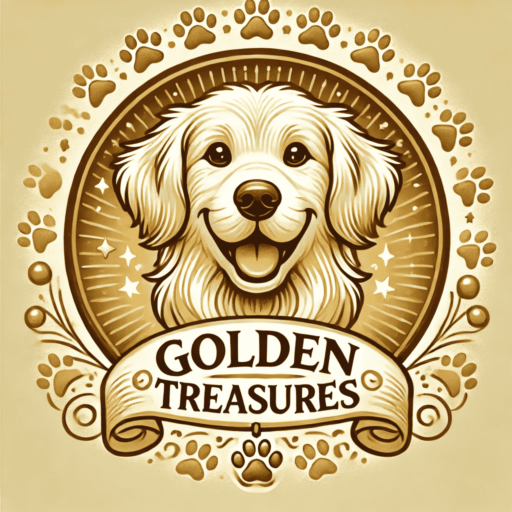
Links will be automatically removed from comments.